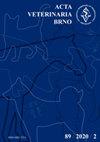环境因素对奶牛呼吸道疾病复合体的影响综述
IF 0.7
4区 农林科学
Q3 VETERINARY SCIENCES
引用次数: 0
摘要
牛呼吸道复杂疾病(BRDC)是一种多因素疾病,除感染因子和动物个体耐药性外,技术、管理和气候因素也起作用。室外小群体饲养在预防BRDC方面具有许多优势。持续实时监测环境因素,如温度、相对湿度、风速、生物气溶胶和有害气体,也有助于防止BRDC的破坏。低温加上较高的相对湿度和风速可导致发病率和死亡率增加。在有毒气体中,氨可能对呼吸系统疾病最重要,因为它直接损害呼吸道,为病原微生物和机会微生物留下空间和打开大门。畜舍的生物气溶胶由饲料、粪便、动物的有机物(如上皮细胞、毛发、尿液、粪便)、微生物和毒素组成。由于其大小,颗粒物(PM)颗粒(PM10和PM2.5)具有重要的健康影响,导致严重的呼吸系统和全身性疾病。颗粒物质的形成和浓度取决于饲养和饲养条件、饲养物种、放养密度、动物活动和环境因素,但也取决于一天内的采样周期。高温、低湿、空气流动(尤其是气流)和动物活动的增加也会导致粪便干燥,导致灰尘的形成和颗粒在空气中传播。随着环境控制的加强,可以更容易地识别气候因素对小牛健康的影响,并采取措施减少这些影响,从而减少可能发生的疾病(主要是呼吸道疾病、BRDC)的发生和损害。本文章由计算机程序翻译,如有差异,请以英文原文为准。
The impact of environmental factors on bovine respiratory disease complex in dairy calves - a review
Bovine respiratory disease complex (BRDC) is a multifactorial disease in which, in addition to infectious agents and the individual resistance of animals, technological, management and climatic factors also play a role. Outdoor rearing in small groups has many advantages in terms of BRDC prevention. Continuous real-time monitoring of environmental factors, such as the temperature, relative humidity, air velocity, bioaerosols and harmful gases can also help to prevent damage by BRDC. Low temperatures in combination with elevated relative humidity and windspeed can lead to increased morbidity and mortality. Among noxious gases, ammonia may be of the greatest importance for respiratory diseases, as it directly damages the respiratory tract, leaving room and opening gate for pathogenic and opportunistic microbes. Bioaerosols of livestock buildings consist of feed, manure, organic matter from animals (e.g., epithelial cells, hair, urine, faeces), microorganisms, and toxins. Due to their size, particulate matter (PM) particles (PM10 and PM2.5) have important health effects, leading to severe respiratory and systemic diseases. Particulate matter formation and concentration depend on the housing and feeding conditions, species housed, stocking density, animal activity and environmental factors, but also on the sampling periods within a day. High temperature, low humidity, air movement (especially drafts), and increased activity of animals also cause the manure to dry, leading to dust formation and particles becoming airborne. With increased environmental control, the effects of the climatic factors on the calves health can be more easily identified, measures can be taken to reduce them, thus the occurrence and damage of possible diseases (mainly respiratory, BRDC) can be decreased.
求助全文
通过发布文献求助,成功后即可免费获取论文全文。
去求助
来源期刊

Acta Veterinaria Brno
农林科学-兽医学
CiteScore
1.00
自引率
33.30%
发文量
36
审稿时长
18-36 weeks
期刊介绍:
ACTA VETERINARIA BRNO is a scientific journal of the University of Veterinary and Pharmaceutical Sciences in Brno, Czech Republic.
The scientific journal Acta Veterinaria Brno is dedicated to the publication of original research findings and clinical observations in veterinary and biomedical sciences. Original scientific research articles reporting new and substantial contribution to veterinary science and original methods that have not been submitted for publication elsewhere are considered for publication. A written statement to this effect should accompany the manuscript, along with approval for publication by the author´s head of department. The authors bear full responsibility for the contents of their contribution. Book reviews are published, too.
 求助内容:
求助内容: 应助结果提醒方式:
应助结果提醒方式:


